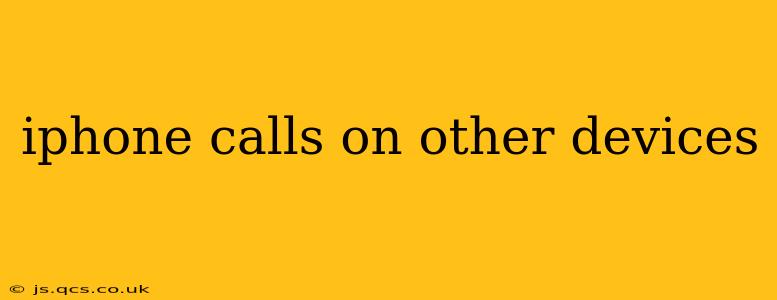Staying connected is crucial in today's fast-paced world. For iPhone users, the ability to make and receive calls on other devices, like iPads, Macs, or even Apple Watches, is a game-changer. This feature, powered by Apple's Continuity ecosystem, seamlessly integrates your iPhone calls across your Apple devices, offering convenience and flexibility. This guide explores how to set up and utilize this powerful functionality, addressing common questions and troubleshooting potential issues.
How Do I Make and Receive iPhone Calls on Other Devices?
This feature relies on having your iPhone nearby and connected to the same Wi-Fi network (or cellular data, if you have it enabled). The core functionality is enabled through iMessage and FaceTime, ensuring a smooth transition between devices. Once set up correctly, incoming calls to your iPhone will simultaneously ring on your other Apple devices. You can answer these calls on any of these devices and the conversation will seamlessly continue. To make an outgoing call, you can simply use the Phone app on your iPad, Mac, or Apple Watch.
Setting Up Calls on Other Devices
-
Ensure Continuity is Enabled: On your iPhone, go to Settings > Phone and make sure Calls on Other Devices is toggled on. This is the foundational step that allows your iPhone calls to be routed to other devices.
-
Sign in with the Same Apple ID: All your devices must be signed in with the same Apple ID and have two-factor authentication enabled for optimal security.
-
Device Compatibility: Ensure your devices meet the minimum system requirements for this feature. Refer to Apple's official support pages for the most up-to-date information on compatible devices and iOS versions.
-
Wi-Fi and Bluetooth Connectivity: While Bluetooth isn't strictly required for making calls, it improves the reliability of the connection, particularly for hand-off between devices. Maintain a strong Wi-Fi connection.
Can I Make Calls From My iPad Without My iPhone Nearby?
No, you cannot make or receive calls from your iPad or other Apple devices without your iPhone being nearby and connected to the same Wi-Fi network (or cellular data). The calls are routed through your iPhone, using it as the central communication hub. Your other devices act as extensions, not independent phone lines.
What Happens if My iPhone is Turned Off or Out of Range?
If your iPhone is turned off, out of range, or otherwise unavailable, you won't be able to make or receive calls on your other devices. The Continuity feature relies on the iPhone's active connection.
Does Using Calls on Other Devices Use My iPhone's Data?
Yes, even when making a call from your iPad or Mac, the call is still routed through your iPhone. Therefore, the call uses your iPhone's data plan or Wi-Fi connection.
How Do I Turn Off Calls on Other Devices?
To disable this feature, simply go back to Settings > Phone on your iPhone and toggle off Calls on Other Devices. Your iPhone will then only ring on itself.
Troubleshooting Calls on Other Devices
If you're experiencing issues with calls not appearing on your other devices, try these troubleshooting steps:
- Check Wi-Fi connection: Ensure your iPhone and other devices are connected to the same stable Wi-Fi network.
- Restart your devices: A simple restart often resolves minor glitches.
- Update iOS/iPadOS/macOS: Ensure all your Apple devices are running the latest software versions.
- Check Apple ID: Verify that all your devices are logged in with the same Apple ID and that two-factor authentication is enabled.
- Contact Apple Support: If the issue persists, contact Apple support for further assistance.
By following these steps and understanding the limitations, you can effectively utilize the iPhone calls on other devices feature, enjoying seamless communication across your Apple ecosystem. Remember, this convenient feature relies on your iPhone being the central communication point, so its availability and connection are key.
